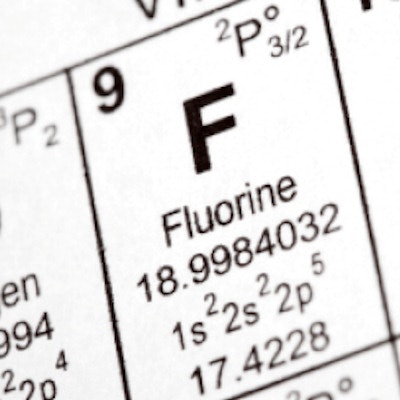
Fluoride levels were higher in the blood of U.S. adolescents with lower renal function, according to a study published June 7 in Environmental Research. The findings suggest a relationship between kidney function, plasma fluoride levels, and the levels of fluoride in community drinking water.
In the study, higher plasma fluoride in children ages 12 to 19 was associated with an increase in water fluoride levels and a decrease in renal function. The investigation used data from 1,841 individuals who participated in the U.S. 2013-2014 and 2015-2016 National Health and Nutrition Examination Survey (NHANES).
"Exposure to levels of fluoride found commonly in drinking water in the United States result in significantly higher levels of fluoride in blood in those with lower kidney function," wrote the authors, led by Dr. John Danziger of Beth Israel Deaconess Medical Center at Harvard Medical School in Boston.
For decades, fluoride has been added to oral health products and drinking water to prevent caries, and community water fluoridation was named one of the major public health advances of the 21st century. However, some recent research has questioned whether fluoride might be tied to adverse effects in children.
Many of these studies, including one from March, involve the use of fluoridated salt, as opposed to the regulated water systems of the U.S. and Canada. But in August 2019, researchers published a study in JAMA Pediatrics that suggested maternal exposure to greater levels of fluoride during pregnancy was linked with lower IQ scores in children ages 3 to 4 in six major Canadian cities. The study included data on fluoride exposure and IQ scores from 512 pairs of mothers and children in which about 40% lived in areas with a fluoridated water supply that was at or below the recommended fluoride level.
This new study raises further questions about the potential adverse effects of community water fluoridation in susceptible individuals. Because fluoride is excreted primarily through the kidneys, the authors wondered whether children with decreasing kidney function might in turn have more fluoride accumulation in their blood.
Their investigation was limited to NHANES participants with socioeconomic data, fluoride levels in blood samples, fluoride levels in household drinking water, and renal function measures. All of the data were only available in children ages 12 to 19, according to the study.
| Characteristics of participants by quartile of estimated glomerular filtration rate (mL/min/1.73m2) | ||||
| <127 | 127 to <134 | 134 to <141 | ≥141 | |
| Plasma fluoride (umol/L) | 0.46 | 0.40 | 0.38 | 0.35 |
| Drinking water fluoride (mg/L) | 0.56 | 0.57 | 0.55 | 0.53 |
| Tap water use | 44% | 49% | 55% | 49% |
Both renal function and household water fluoride levels were correlated with plasma fluoride concentration in the authors' weighted and adjusted analyses. A 10 mL/min/1.73 m2 dip in renal function was associated with a 0.02 umol/L increase in plasma fluoride levels. A 1 mg/L increase in water fluoride levels was tied to a 0.23 increase in plasma fluoride levels.
Additionally, correlation between water and plasma fluoride levels was strongest among individuals with the lowest renal function. For those in the quartile with the lowest kidney function, a 1 mg/L higher drinking water fluoride concentration was associated with a 0.35 umol/L higher plasma fluoride level. In comparison, water fluoridation concentration was linked with a 0.20 umol/L plasma fluoride level in those with the highest renal function, they wrote.
The blood fluoride concentrations in the study fall below the 4.1umol/L threshold for excessive fluoride exposure. People exposed to fluoride-treated water generally have blood plasma levels between 1 and 4 umol/L, according to Mayo Clinic Laboratories.
The study was limited by the use of mathematical estimates of renal function, which lack the precision to accurately quantify renal function, the authors wrote. Further, the researchers accounted for fluoride in toothpaste and water but did not address other fluoride sources.
While the findings were modest in the young, healthy population studied, the authors expressed their concern that fluoride accumulation may be underestimated in Americans with chronic kidney disease. More research is needed on whether people with kidney disease have a greater susceptibility to fluoride from environmental exposure, Danziger and colleagues concluded.
"Our analysis suggests higher levels of plasma fluoride accumulation in those with lower renal function is of public health concern," they wrote. "Given that there are more than 20 million Americans living with [chronic kidney disease], among whom the hazard of fluoridation would be highest in those with severe disease, further research is needed to assure water safety for all."




















